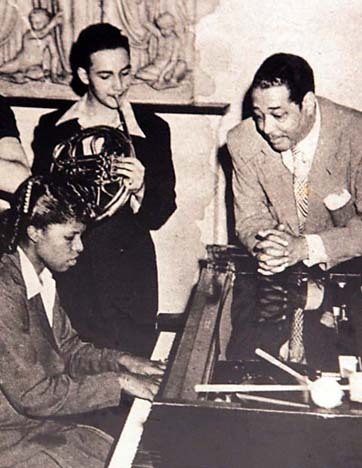
San Francisco Symphony/SF Opera timpanist Elayne Jones, who died last month at age 94, lived many lives, met multifarious challenges, and became the center of a national controversy about racial discrimination in classical music.
In her autobiography, Little Lady With a Big Drum, Jones recalled being hired by the SF Symphony in 1972 from a blind audition of 40 applicants. “I represented a triple threat. Bad enough that I was Black and doubly disgusting that I was a woman. But for a Black woman to have the audacity to play a ‘male’ instrument, the timpani, well, that was just too much.”
After nearly two years of proving herself over and over again, she was up for tenure, fully expecting to receive it — but she was turned down, and the event created controversy going far beyond the confines of one orchestra.
“I had been playing steadily with this highly rated orchestra. I toured with them in Europe and the Soviet Union. My playing was praised everywhere. My appearance was unusual, according to conductors and critics. I was mobbed by enthusiastic fans in London, Berlin, and Moscow. There is little, in fact no reason, to believe I would not be granted tenure.”

Ready to celebrate, Jones stopped at her neighborhood Safeway and bought a bottle of champagne, “sharing my good news with the checkout clerk: ‘I’m going to have a big celebration on my way toward being a role model for other Black musicians.’”
A single mother, with three teenage children, ready to celebrate becoming the first Black musician to be a tenured member of a major American orchestra, she was devastated when notified by a phone call — and without explanation — that she was denied tenure.
“The news of the denial flared around the world. People began calling me not only in San Francisco but also from New York and Europe.” Six players, all white, hired at the same time with Jones, were all given permanent positions in 1974. One other player had been denied tenure, Ryohei Nakagawa, a young bassoonist from Japan. He returned home, but Jones stayed in San Francisco.
Robert Commanday, then chief classical music critic of the SF Chronicle, called the decision to deny tenure “scandalous” and kept covering the story, along with the SF Examiner and East Coast newspapers.

“The details of Jones’s tenure case involve skirmishes of power between multiple parties — unions, orchestral players, management, and [Music Director Seiji] Ozawa,” wrote academic Grace Wang in a study of racial discrimination in classical music. “Jones spent decades repeatedly proving her ability and musical worth. When she learned of the shockingly low scores she received for her tenure, they felt like a personal assault to diminish and demean.”
The orchestra before 1980 also played for SF Opera and SF Ballet, and in 1975, SF Opera General Director Kurt Herbert Adler kept Jones as the timpanist for the orchestra when it played for the Opera, and she held that position for the next 23 years.
Singer Kevin Langan, a featured soloist with SF Opera for three decades from 1980, told SF Classical Voice:
“Elayne was in the Opera Orchestra for most of my career. She always had a smile on her face and a compliment to give me almost every night. She was a delightful musician, and my memories are of a wonderful colleague. R.I.P. Elayne. I always looked down and to the left at curtain calls to see her gleaming smile looking back up at me.”
In 1998, at age 70, Jones retired from SF Opera to spend more time with her family. She also gave hundreds of lectures at schools in the Bay Area, Barbados, and all around the country.
Jones was born on Jan. 30, 1928, in New York City’s Harlem neighborhood, where her parents had moved from Barbados. Her father was a Linotype operator, her mother a pianist. “Their lives were rigidly proscribed by housing segregation, job discrimination, and prejudice,” Jones wrote in her autobiography. Her parents ended up working as a porter and a domestic, respectively, giving up their dreams of running a printshop and, for her mother, a career as a concert pianist.
Jones started taking piano lessons early and sang in the choir at St. Luke’s Episcopal Church. When she joined a Girl Scout drum and bugle corps, she was told that “I was too skinny to blow a horn ... was given a pair of drumsticks, and I carried the drum, too.”

In 1942, Jones was accepted to the High School of Music & Art in New York — now known as the Fiorello H. LaGuardia High School of Music and the Arts. In a 2020 article for Allegro, the magazine of the New York City musicians’ union Local 802, Barbara Steinberg described the scene: “As students lined up to pick an instrument, Elayne stared at how many there were to choose from. The violin felt like a good fit, but her teacher didn’t even measure her. The strings teacher declared that she was ‘too skinny’ to play the violin and walked out of the room. But he came back with the brass and percussion teacher, who handed her a pair of drumsticks and said, ‘I recommend you study the drums. We all know Negroes have rhythm.’”
When she graduated from high school with awards, Jones became one of the students to receive a scholarship from Duke Ellington and be accepted to The Juilliard School. There, she studied with New York Philharmonic timpanist Saul Goodman. “I think I was his first serious female student, and I believe he realized that I might have some of the same difficulties that he had as a short Jewish man because I was a skinny Black girl.”
Following graduation from Juilliard in 1949, Jones found work with the New York City Opera and New York City Ballet Orchestras. On tour with the companies, she was forced to sleep in separate hotels from the other musicians, stopped at stage doors as white colleagues walked through, and was told to perform hidden from view.
Beginning in 1958, she became a substitute player with the New York Philharmonic, the orchestra’s first Black musician.
Jones was a founding member of the integrated Symphony of the New World in 1965 and a force behind the drive to have orchestral auditions behind a screen to reduce bias — a practice adopted early by the SF Symphony. She played with Leopold Stokowski’s American Symphony Orchestra through 1972.
And then the chapter of her career in San Francisco, described in Wang’s article as “a city that looms large in her own life narrative. When she arrived in San Francisco, the local press heralded her position with the orchestra as evidence of the city’s progressiveness. But Jones soon encountered significant backlash, including a well-publicized tenure denial.
“She never visited the city before but quickly fell in love, enraptured by the scent of eucalyptus leaves in Golden Gate Park, the ease of mild winters, and the colorful architecture that seemed to exude optimism and promise. She believed San Francisco represented a place less entrenched in racism. She left New York fully expecting to remain with the SF Symphony until her retirement ... [but found once again] the accumulated costs of pursuing artistic excellence in the face of persistent racial and gender exclusions.”
Jones is survived by a daughter, Cheryl Stanley, with whom she lived in Walnut Creek; a son, Stephen Kaufman, a traveling musician and performance artist known as Thoth, currently residing in Mexico; another daughter, Harriet Kaufman Douglas, of Akosombo, Ghana; three grandchildren; and three great-grandchildren.

